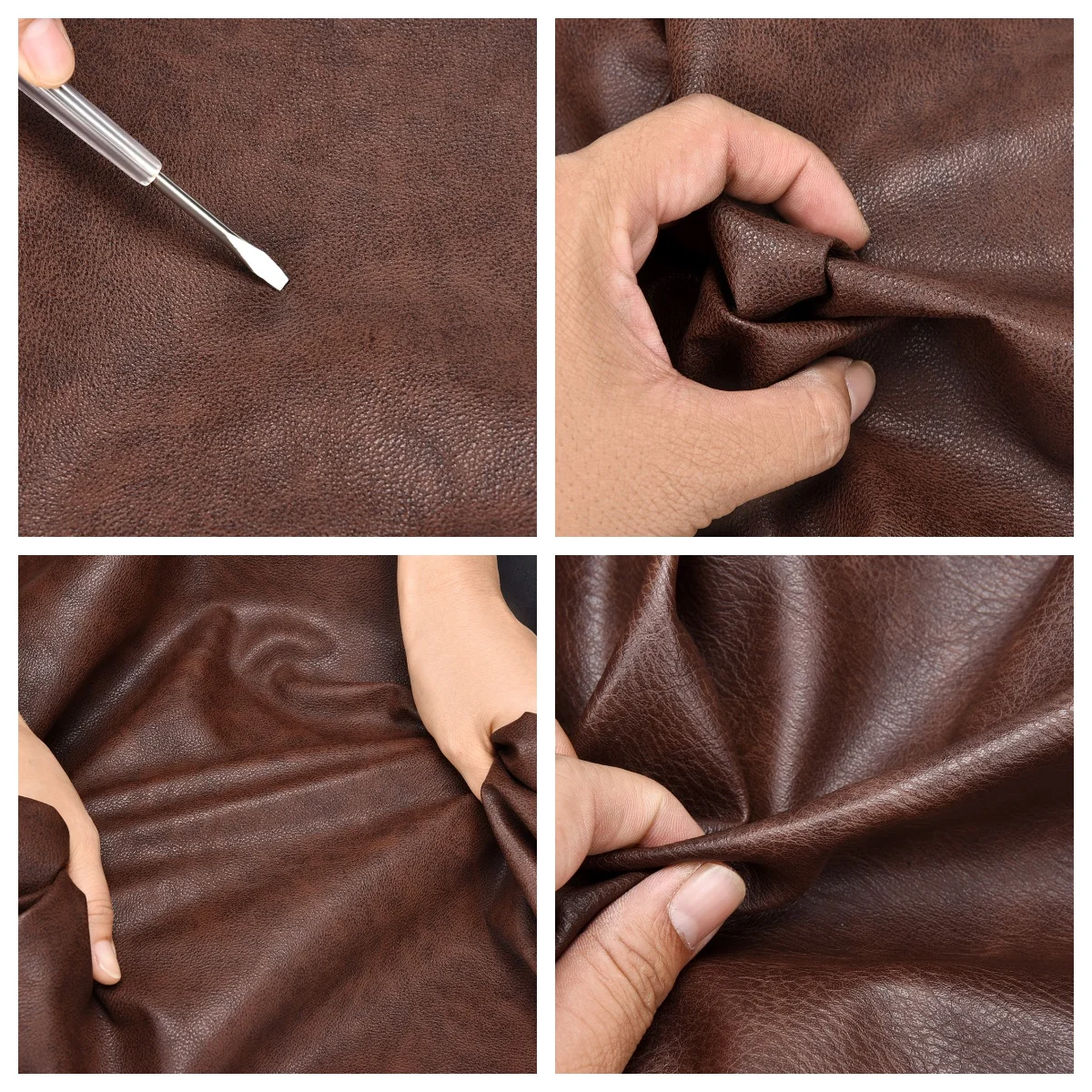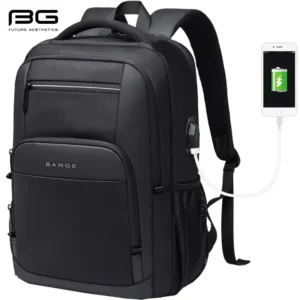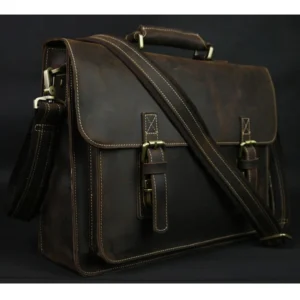Introduction: Why Investing in a Durable Leather Backpack Matters
In a world where disposable fashion dominates, choosing a leather backpack that can truly handle daily use represents more than just a purchase—it’s an investment in reliability. When we talk about a backpack that “handles daily use,” we’re referring to a combination of enduring durability, practical functionality, and unwavering reliability that supports your everyday life.
The difference between quality leather and cheaper alternatives becomes apparent within months, not years. While synthetic backpacks might serve you for 1-2 years before showing significant wear, a well-crafted leather backpack can be your faithful companion for 5-10+ years—often improving in appearance as time passes.
When searching for a leather backpack built for daily demands, focus on:
- Quality of leather (full-grain being the gold standard)
- Robust construction methods and reinforced stress points
- Premium hardware that won’t fail after repeated use
- Thoughtful design that accommodates your daily essentials
Perhaps most remarkably, unlike synthetic materials that simply wear out, quality leather develops a beautiful patina over time—a unique finish that tells the story of your journeys together. This natural aging process means your backpack doesn’t just endure daily use—it evolves and improves through it.
As we explore the world of durable leather backpacks for commuters, you’ll discover why these timeless accessories remain the preferred choice for those who value longevity over temporary solutions.
Why Full-Grain Leather Excels for Daily Use Backpacks
The Superior Structure of Full-Grain
Full-grain leather stands head and shoulders above other materials when it comes to creating backpacks that truly withstand daily use. This premium leather includes the entire top layer of the hide with all of its natural grain intact, preserving the strongest and most densely packed fibers. The result is exceptional tear resistance, superior abrasion protection, and a material that can handle the constant stresses of daily carry.
Unlike corrected-grain leathers, full-grain contains all the natural characteristics and markings that give each piece its unique character. These natural variations aren’t flaws—they’re signatures of authenticity that become more pronounced and beautiful over time.
The Patina Advantage
One of the most remarkable qualities of full-grain leather is how it transforms with use. Rather than deteriorating, it develops a rich patina—a warm glow and softened texture that reflects its journey with you. This natural aging process creates a personalized finish that synthetic materials simply cannot replicate. Your backpack essentially becomes more attractive the more you use it, developing deeper tones and a supple feel unique to your carrying patterns.
Natural Resilience
Full-grain leather offers natural water resistance that surpasses other leather types. The tight fiber structure creates an inherently protective barrier against light moisture. While not completely waterproof without treatment, full-grain leather repels light rain and recovers from occasional exposure better than its counterparts.
The Hierarchy of Leather Quality
When compared to other leather varieties, the differences become clear:
Top-grain leather, while still durable, has had its uppermost layer sanded away to remove imperfections, sacrificing some strength and character development in the process.
Genuine leather, despite its authentic-sounding name, is actually made from lower layers of the hide after the stronger top portions have been removed. It lacks the fiber density and natural strength of full-grain, making it unsuitable for backpacks subjected to daily stress.
For backpacks that truly need to withstand years of daily use, full-grain leather backpacks represent the pinnacle of material quality—an investment that continues to reward you with each passing year.
Key Construction Features That Ensure Long-Term Durability
The material is just the beginning—how that leather is transformed into a backpack determines whether it will truly withstand daily demands. When evaluating construction quality, pay attention to these critical elements:
Stitching That Stands the Test of Time
- Saddle stitching: This traditional technique creates a staggered, interlocking pattern that won’t unravel even if one section breaks. Machine stitching, while efficient, creates a chain stitch that can completely unravel if a single thread fails.
- Thread quality: Look for marine-grade polyester or waxed linen threads with high tensile strength (400-600+ lbs).
- Stitch density: Tighter, more numerous stitches create stronger seams that distribute tension across more points.
Reinforcement at Critical Stress Points
- Double-layered leather at strap connections and bottom panels where wear is most severe
- Bar-tacking (dense zigzag stitching) at corners and any point where straps meet the body
- Rivets or metal reinforcements at key connection points, providing strength beyond what stitching alone can offer
Hardware That Won’t Let You Down
- Solid brass or stainless steel hardware instead of plated metals that chip and corrode
- YKK or RiRi zippers with smooth action and self-healing capabilities
- Buckles with properly finished edges to prevent cutting into leather over time
- Metal D-rings and attachment points rather than plastic components
Strategic Panel Construction
- Minimized seams for greater structural integrity—each seam represents a potential failure point
- Single-piece back panels that distribute weight evenly without weak points
- Rolled edges that resist fraying and prevent moisture penetration
The ultimate guide to durable leather backpacks explains how these construction elements work together to create a unified whole that stands up to daily challenges. When these features are combined with quality materials, the result is a backpack that doesn’t just survive daily use—it thrives under it.
Essential Comfort Features for Everyday Carrying
A backpack that’s built to last won’t serve you well if it’s uncomfortable for daily carry. The ergonomics of your leather backpack directly impact your physical well-being when carrying it day after day.
Strap Engineering for All-Day Comfort
The humble backpack strap deserves more attention than it typically receives. Quality leather backpacks feature:
- Contoured straps that follow the natural curve of your shoulders
- Strategic padding placement focused on pressure points, not just uniform thickness
- Width that distributes weight across a broader area (typically 2-2.5 inches)
- Adjustable length mechanisms that don’t slip during daily movement
Back Panel Design
The part of your backpack that rests against your body significantly impacts comfort:
- Light padding that provides cushioning without excessive bulk
- Strategic airflow channels that minimize sweating during commutes
- Semi-rigid construction that prevents contents from pressing into your back
- Natural leather breathability that outperforms many synthetic materials
Weight Management Features
Even the most comfortable straps can’t compensate for poor weight distribution:
- Centered load positioning that keeps weight close to your body’s center of gravity
- Compression straps that prevent contents from shifting during movement
- Hip belts or stabilizer straps on larger models to transfer weight from shoulders
- Balanced pocket placement that encourages even weight distribution
Carrying Alternatives
Daily use often involves transitions between carrying styles:
- Reinforced top handles designed for proper weight distribution when hand-carried
- Side handles for horizontal carrying in crowded spaces
- Quick-grab features for situations where donning both straps isn’t practical
Proper backpack weight management becomes increasingly important as your daily carry needs grow. The most durable backpack will become a burden if it causes physical discomfort—making ergonomic design just as crucial as durability for truly daily use.
Organization Systems That Support Daily Functionality
Even the most durable backpack falls short if its organization doesn’t support your daily routine. Thoughtful internal layout transforms a simple carrying vessel into a tool that enhances your productivity.
Dedicated Tech Protection
Modern daily carry inevitably includes electronics that require protection:
- Padded laptop compartments with secure closures to prevent shifting
- Suspended design that keeps devices elevated from the bottom (protecting from impacts)
- Appropriate sizing that accommodates standard devices (13” laptops need approximately 9.5” × 13.5” compartments, 15” laptops need 10.5” × 15.5”, and 17” laptops need 12” × 17”)
- Microfiber linings that prevent scratches on screens and surfaces
Quick-Access Essentials
Items you reach for multiple times daily deserve dedicated spaces:
- Front or side pockets positioned for one-handed access
- Security features that maintain accessibility without compromising protection
- Key leashes or designated key pockets that prevent hunting through larger compartments
- Sunglasses pouches with protective linings
Adaptive Main Compartments
The core carrying space needs to accommodate changing daily needs:
- Minimal internal dividers that allow flexibility in what you carry
- Sufficient depth for bulkier items while maintaining a streamlined profile
- Light-colored linings that improve visibility of contents
- Strategic pockets that maintain organization without excessive compartmentalization
External Utility Features
Practical external elements enhance daily functionality:
- Water bottle holders designed to securely hold standard bottle sizes (typically 2-3” diameter)
- Magazine or document sleeves for flat items requiring quick access
- Hidden security pockets for valuables that require additional protection
The best leather backpacks with multiple compartments balance organization with simplicity. An overly complicated system with too many tiny pockets creates frustration, while too few organizational features leaves your belongings in disarray. The ideal balance creates intuitive spaces that naturally accommodate your daily essentials.
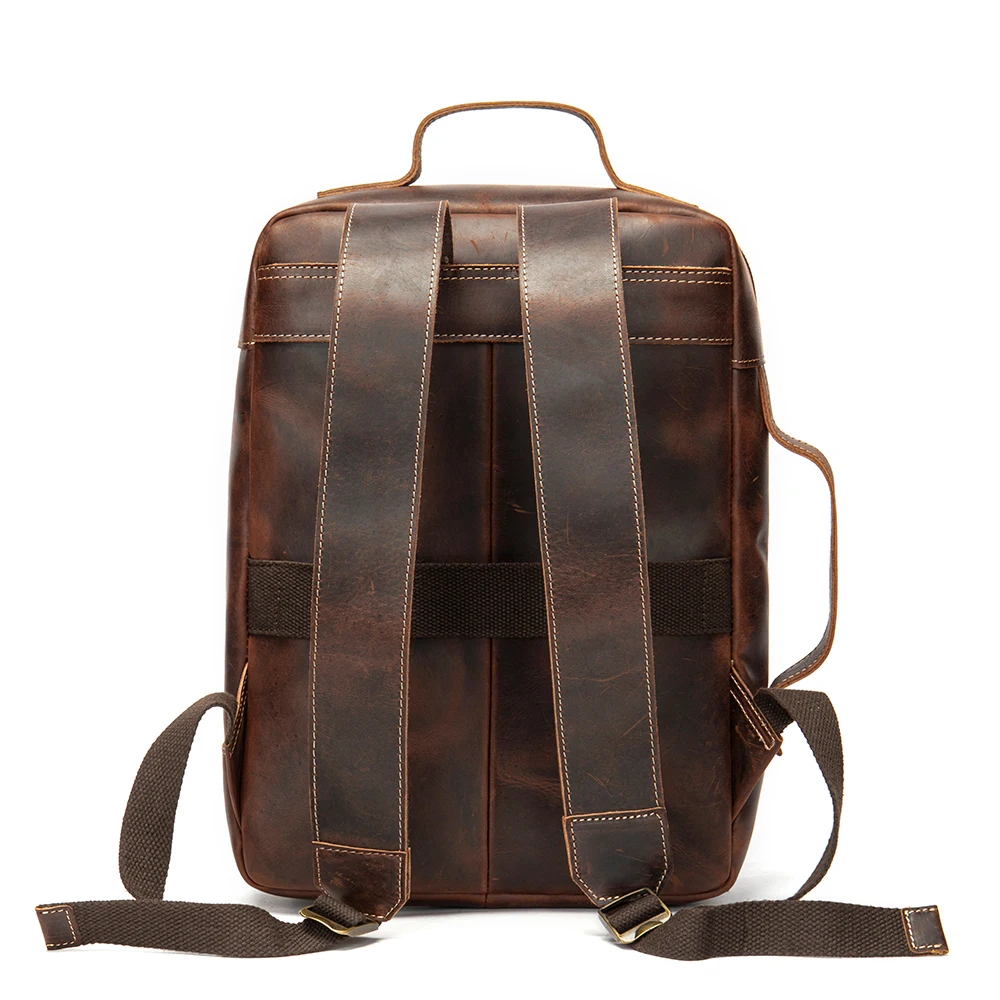
Balancing Size and Capacity for Different Daily Needs
Finding the perfect size backpack for daily use requires understanding both your carrying needs and physical proportions. A backpack that’s too large becomes cumbersome, while one that’s too small leaves you unable to carry essentials.
Size Categories for Daily Use
| Size Category | Capacity (Liters) | Ideal Daily Use Case | Typical Dimensions |
|---|---|---|---|
| Compact | 15-20L | Minimalist carry, tablets, light lunch, essentials | 16”H × 12”W × 4-5”D |
| Medium | 20-25L | Standard laptop, lunch, water bottle, light jacket | 18”H × 13”W × 6-7”D |
| Large | 25-30L+ | Large laptop, gym clothes, meal prep, books | 20”H × 14”W × 8-9”D |
Finding Your Proportional Match
The most comfortable backpack typically has a height that doesn’t extend above your shoulders or below your lower back. Width should generally not exceed the width of your torso, ensuring the bag doesn’t catch on doorways or crowd others in tight spaces.
Considering Daily Commute Realities
Your regular transportation method impacts ideal sizing:
- Public transit commuters benefit from slimmer profiles that navigate crowded spaces
- Bike commuters need secure, close-fitting designs that don’t shift during movement
- Car commuters might prioritize capacity over compact dimensions
Capacity Flexibility Features
Some leather backpacks offer clever design solutions for varying capacity needs:
- Expandable main compartments that adapt to changing daily requirements
- Compression straps that maintain a slim profile when not fully loaded
- Modular attachment points for occasional extra items
Understanding what size backpack is best for commuting helps you find the sweet spot where capacity meets comfort. The perfect size supports your daily needs without becoming the oversized burden that gets left at home when you need it most.
Weather Resistance: Protecting Your Daily Companion
A backpack that truly handles daily use must navigate various weather conditions while keeping your belongings protected. Quality leather offers natural advantages in this regard, but understanding its limitations—and how to enhance its protective qualities—is essential.
Natural Weather Resistance of Quality Leather
Full-grain leather provides inherent protection against light moisture thanks to its:
- Natural oils that repel water droplets
- Tight fiber structure that slows moisture penetration
- Ability to dry without losing structural integrity when properly cared for
Enhancing Weather Protection
To improve your leather backpack’s ability to handle unpredictable weather:
- Apply quality leather conditioner with water-repellent properties every 3-6 months
- Use specialized leather waterproofing products that maintain breathability
- Allow wet leather to dry naturally at room temperature, away from direct heat
- Consider leather waxes for areas most exposed to moisture, like top flaps
Protective Design Elements
Smart design features enhance weather resistance:
- Flap-over tops that direct water away from zipper openings
- Storm flaps covering external zippers
- Rolled or folded seams that prevent water from seeping through stitch holes
- Interior linings that provide secondary moisture barriers
Weather Expectations and Limitations
While leather can be made highly weather-resistant, understanding its natural limitations helps set realistic expectations:
- Occasional rain exposure is manageable with proper care and treatment
- Extended downpours require additional protection (like a rain cover)
- Extreme conditions may require alternative materials for specific situations
For the widest range of daily weather conditions, men’s leather backpacks with thoughtfully designed weather protection offer the perfect balance of style, durability, and practical functionality without requiring excessive maintenance.
Top 5 Leather Backpacks Built for Daily Reliability
After evaluating dozens of leather backpacks against strict criteria for daily use durability, these five standouts deliver exceptional performance where it matters most.
1. The Summit Carry Executive
Key Durability Features:
– Full-grain vegetable-tanned leather (2.2mm thickness)
– Reinforced saddle stitching at all stress points
– Marine-grade polyester thread with 600lb tensile strength
– Solid brass hardware with smooth-action YKK zippers
Daily Functionality:
– Padded 15” laptop compartment with suspended design
– Quick-access front pocket with organizational panel
– Adjustable ergonomic straps with memory foam padding
– Side water bottle pocket with elastic retention
Pros:
– Exceptional build quality with lifetime durability
– Balanced weight distribution even when fully loaded
– Professional aesthetic suitable for office environments
– Develops beautiful patina with regular use
Cons:
– Higher initial investment
– Requires occasional leather maintenance
– Heavier than synthetic alternatives (3.4 lbs empty)
2. The Summit Carry Commuter Classic
Key Durability Features:
– Oil-tanned full-grain leather with water-resistant properties
– Double-layer reinforcement at bottom panel and strap anchors
– Riveted stress points with copper hardware
– Weather-resistant zipper design with protective flaps
Daily Functionality:
– Roll-top design with adjustable capacity (18-22L)
– External quick-access pocket for essentials
– Padded back panel with airflow channels
– Convertible tote-style carrying option
Pros:
– Highly versatile for varying daily loads
– Superior weather resistance for unpredictable conditions
– Contemporary styling that works across casual and professional settings
– Comfortable for extended wearing periods
Cons:
– Limited internal organization
– Roll-top access slower than traditional zipper designs
– Color darkens noticeably with use (part of natural patina development)
3. The Summit Carry Minimalist
Key Durability Features:
– Single-piece front and back panel construction (minimal seams)
– Full-grain leather with pull-up effect
– Reinforced base with protective metal feet
– Hidden seam construction for improved water resistance
Daily Functionality:
– Sleek profile ideal for urban commuting
– Padded tablet/small laptop sleeve (up to 13”)
– Accessible front stash pocket with magnetic closure
– Contoured straps with adjustable positioning
Pros:
– Lightest weight option (2.7 lbs empty)
– Clean aesthetic that pairs with any style
– Easiest to maintain with simple design
– Perfect size for essential daily carry
Cons:
– Limited capacity for larger daily needs
– Fewer organizational features
– Less padding than larger models
14 Inch Leather Laptop Backpack, Brown Leather Backpack, Men's Leather Backpack, Vintage Leather Backpack
Price range: $177.28 through $199.12 Select options This product has multiple variants. The options may be chosen on the product pageDesigner Men's Backpack, Men's Leather Laptop Backpack, Men's Leather Work Backpack
Price range: $158.04 through $160.04 Select options This product has multiple variants. The options may be chosen on the product pageDesigner Mini Backpack, Mini Leather Backpack, Small Leather Sling Backpack, Women's Leather Backpack
Price range: $95.76 through $98.80 Select options This product has multiple variants. The options may be chosen on the product pageDesigner Mini Backpack, Designer Women's Backpack, Mini Leather Backpack, Women's Leather Backpack
Price range: $135.92 through $137.64 Select options This product has multiple variants. The options may be chosen on the product page15 Inch Leather Laptop Backpack, Leather Briefcase Backpack
$332.96 Select options This product has multiple variants. The options may be chosen on the product page17 Inch Leather Laptop Backpack, Men's Leather Travel Backpack, Men's Leather Work Backpack
Price range: $106.28 through $143.88 Select options This product has multiple variants. The options may be chosen on the product page
4. The Summit Carry Professional Plus
Key Durability Features:
– Premium full-grain leather with semi-gloss finish
– Double-needle lockstitch construction throughout
– High-density foam structure maintains shape even when empty
– Metal frame opening for consistent access and durability
Daily Functionality:
– Doctor-bag style wide opening for excellent visibility
– Multiple dedicated tech sleeves (laptop + tablet)
– Exterior organizational pockets with business card slots
– Trolley sleeve for attachment to rolling luggage
Pros:
– Exceptional organization for professional tools
– Stands upright when placed on floor
– Most formal aesthetic for business environments
– Quickest access to main compartment contents
Cons:
– Less comfortable for extended carrying
– More structured design adds weight (3.8 lbs empty)
– Premium pricing reflects business-focused features
5. The Summit Carry Adventure Daily
Key Durability Features:
– Thick full-grain leather with visible natural grain
– Reinforced carrying handle with steel core
– Heavy-duty webbing supports underlying leather straps
– Water-resistant treatment applied during manufacturing
Daily Functionality:
– Expanded capacity design (25-28L)
– Side and front compression straps
– Hidden back panel security pocket
– Adjustable sternum strap for heavy loads
Pros:
– Highest capacity for demanding daily needs
– Most versatile for varied environments (office to outdoors)
– Superior weight management features
– Most weather-resistant design
Cons:
– Casual styling less suited for formal environments
– Bulkier dimensions not ideal for crowded commuting
– Heaviest option (4.1 lbs empty)
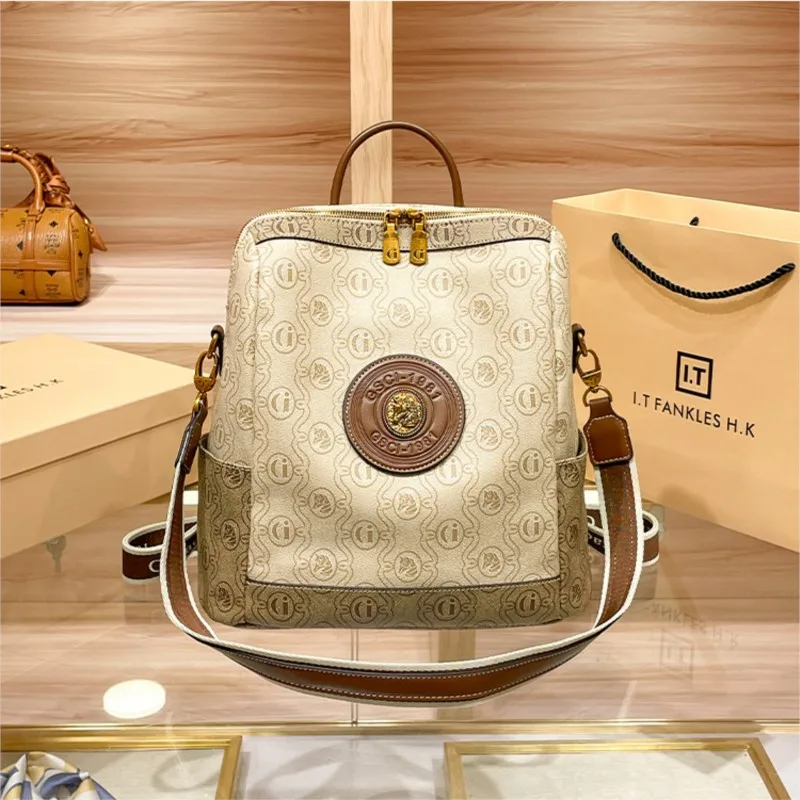
For those seeking options specifically designed for women, our collection of women’s leather backpacks offers tailored dimensions and designs while maintaining the same commitment to daily durability.
The Economics of Investing in Quality: Cost-Per-Use Analysis
When evaluating the price of a quality leather backpack—typically ranging from $200 to $400—the initial investment can seem significant. However, understanding the economics of this purchase through cost-per-use analysis reveals why it’s actually the more financially sound choice over time.
Cost-Per-Use Calculation
The simple formula reveals the true value of quality goods:
Cost-per-use = Purchase price ÷ Number of uses
Let’s apply this to a real-world scenario:
Quality Leather Backpack:
– Initial cost: $300
– Lifespan with proper care: 10 years of daily use (approx. 2,500 uses)
– Cost-per-use: $300 ÷ 2,500 = $0.12 per use
Synthetic Alternative:
– Initial cost: $80
– Lifespan before failure: 1.5 years of daily use (approx. 375 uses)
– Cost-per-use: $80 ÷ 375 = $0.21 per use
– Over 10 years, you’d need approximately 6-7 replacements, totaling $480-$560
The Hidden Value of Quality
Beyond the pure financial calculation, quality leather backpacks offer additional economic benefits:
- Reduced shopping time and decision fatigue from frequent replacements
- Consistent organization system that doesn’t require readjustment with new bags
- Lower environmental impact from reduced consumption
- Increasing aesthetic appeal as patina develops (unlike synthetic materials that simply look worn)
The economic advantage of long-lasting leather commuter bags becomes even clearer when considering these leather backpacks often look better after years of use than synthetic options do after months. This creates both practical and aesthetic longevity that synthetic alternatives simply cannot match.
Essential Care Tips to Maximize Your Backpack’s Lifespan
Even the highest quality leather backpack requires proper maintenance to reach its full potential lifespan. Following these simple care routines ensures your daily companion serves you faithfully for years.
Regular Cleaning Routine
- Empty all pockets completely before cleaning
- Use a soft brush to remove surface dust and debris
- Wipe down with a slightly damp cloth (not wet)
- Allow to dry completely at room temperature
- For stubborn dirt, use a specialized leather cleaner following product instructions
Conditioning Schedule
- Apply quality leather conditioner every 3-6 months depending on use
- Use a small amount—leather should absorb the conditioner without surface residue
- Pay special attention to high-flex areas like strap connections
- Allow 24 hours for conditioner to fully absorb before heavy use
- Choose conditioners appropriate for your specific leather type
Proper Storage Practices
- Store upright or hanging when not in use
- Use light stuffing to maintain shape during extended storage
- Keep away from direct sunlight and heat sources
- Allow air circulation rather than storing in plastic
- If storing long-term, condition before storage and periodically check condition
Addressing Common Wear Issues
- Small scratches often buff out with gentle fingertip friction
- Minor scuffs can be remedied with appropriate leather cream
- Loose threads should be carefully trimmed, never pulled
- Hardware issues should be addressed immediately before they affect leather
- Water spots should be allowed to dry naturally, then conditioned
Understanding these leather commuter backpack care tips ensures your investment remains both functional and beautiful throughout its extended lifespan. With minimal regular attention, your leather backpack will continue to serve reliably while developing the character that makes leather goods so prized.
What To Look For When Evaluating Leather Quality
Even when a manufacturer claims “genuine leather,” significant quality variations exist that directly impact durability. Learning to evaluate leather quality yourself ensures you’re truly getting a backpack built for daily demands.
Visual Assessment Checklist
- Natural grain patterns: Look for subtle variations and pores that indicate natural, unaltered leather surface
- Edge finishing: Quality leather has cleanly cut, properly finished edges that resist fraying
- Thickness consistency: Premium backpacks maintain appropriate thickness throughout, without overly thin sections
- Cut quality: Panels should be cut with the grain direction aligned for optimal strength
- Dye penetration: Quality-dyed leather shows consistent coloration when you examine inside edges
- Surface treatments: Be wary of excessive surface coating that masks natural leather characteristics
Tactile Evaluation Techniques
- Flexibility test: Quality leather should flex without cracking while maintaining structure
- Temperature feel: Real leather feels cool to the touch initially, then quickly warms
- Scent check: Genuine full-grain leather has a distinctive natural smell, not chemical or plastic
- Water drop test: Place a small water droplet on an inconspicuous area—quality leather causes it to bead up initially rather than immediately absorbing
- Thickness measurement: For daily use backpacks, look for leather at least 1.8-2.0mm thick in main panels
Red Flags for Poor Quality
- Perfectly uniform surface without natural variations
- Overly stiff or completely floppy behavior
- Strong chemical smell rather than natural leather scent
- Extremely light weight compared to size
- Very consistent, machine-perfect edge work throughout
Understanding the classic leather backpack construction fundamentals helps you recognize the difference between marketing claims and genuine quality. The backpack that truly handles daily use will showcase these quality indicators throughout its construction.
Are Leather Backpacks Worth It for Daily Use?
Addressing Common Concerns
Weight Considerations
While leather backpacks typically weigh more than synthetic alternatives (usually 2.5-4 pounds empty versus 1-2 pounds), this additional weight comes with structural benefits. The weight distribution in quality leather backpacks is typically more balanced, and the material’s natural conforming properties often make them feel more comfortable once broken in, despite the additional ounces.
Maintenance Requirements
Leather does require periodic care, but this is often overstated. A simple conditioning every few months takes just minutes and becomes a satisfying ritual rather than a burden. Compare this to synthetic backpacks that can’t be restored once they begin deteriorating, and the maintenance equation shifts significantly in leather’s favor.
Price Justification
The higher upfront cost of quality leather represents materials that last years longer, construction techniques that prevent premature failure, and designs that age gracefully rather than simply wearing out. For those who use their backpack daily, this investment amortized over years of use becomes remarkably reasonable.
When Leather Excels for Daily Use
Leather particularly shines in these daily scenarios:
- Professional environments where appearance matters alongside function
- Variable conditions where adaptability to different settings is valuable
- Situations where you need a bag that grows more comfortable over time
- When you value the ability to repair rather than replace
When Alternative Materials Might Be Better
To provide balanced perspective, leather may not be ideal for:
- Extremely wet environments with constant, heavy rain exposure
- Situations requiring absolute minimum weight (ultralight needs)
- Those with ethical concerns about animal products
- Specialized activities requiring technical performance fabrics
The exceptional benefits of sturdy leather backpacks become most apparent through daily use over time. For most daily carrying scenarios, the combination of durability, comfort, and developing character makes leather the superior choice despite the higher initial investment.
Frequently Asked Questions About Daily Use Leather Backpacks
How do I break in a new leather backpack?
Breaking in a new leather backpack helps it conform comfortably to your body while developing initial character. Start by lightly conditioning the entire bag, focusing on strap areas and fold points. Use the backpack with lighter loads initially, gradually increasing as the leather begins to soften. Natural body heat and movement will accelerate the process. Avoid artificially speeding break-in with excessive water or heat, as these can damage the leather’s structure.
Will my leather backpack be ruined if it gets caught in rain?
Occasional rain exposure won’t ruin quality leather backpacks. If your bag gets wet, gently blot (don’t rub) excess moisture with a towel, then allow it to dry naturally at room temperature away from direct heat sources. Once completely dry, apply a small amount of conditioner to restore moisture balance. Water spots on untreated leather can usually be minimized with proper drying and conditioning, though repeated heavy soaking should be avoided.
How long should a quality leather backpack last with daily use?
With proper care, a well-constructed full-grain leather backpack should last 7-10+ years of daily use. Many continue to function well beyond this timeframe, though aesthetic preferences or changing needs might prompt replacement before the bag fails structurally. The first signs of aging typically appear in high-friction areas like edges and straps, though these can often be maintained or repaired to extend lifespan.
Are leather backpacks too heavy for comfortable daily carrying?
The weight difference between quality leather and synthetic backpacks is typically 1-2 pounds when empty. However, leather’s superior structure often distributes weight more effectively, potentially making it more comfortable for daily use despite the additional weight. Proper ergonomic design with padded straps and back panels can further offset the weight difference, making it negligible for most users during normal daily carrying.
How often do leather backpacks need conditioning?
For backpacks in regular daily use, conditioning every 3-6 months is typically sufficient. Environmental factors like humidity, temperature variations, and exposure to elements may necessitate more frequent care. Signs that your backpack needs conditioning include leather feeling dry or stiff, developing a lighter appearance than normal, or showing minor surface cracking when flexed.
When choosing a rugged leather backpack, understanding these maintenance requirements helps set appropriate expectations for the care investment required to maximize longevity.
From Daily Commuter to Weekend Warrior: Versatility in Use
The true value of a quality leather backpack emerges in its versatility across different scenarios. Unlike specialized bags designed for single purposes, a well-designed leather backpack transitions seamlessly between diverse uses.
Professional to Casual Transition
Monday through Friday, your leather backpack carries laptops, documents, and professional essentials with an aesthetic that complements business attire. The same bag transforms for weekend use—carrying water bottles, snacks, and casual gear without missing a beat. This adaptability eliminates the need for multiple specialized bags cluttering your closet.
Design Elements That Enhance Versatility
Versatile leather backpacks incorporate thoughtful features that support multiple use cases:
- Removable laptop sleeves that convert main compartments from tech-focused to general use
- Expandable capacity systems that adapt to varying load requirements
- Compression straps that maintain a slim profile when under-packed
- Neutral styling that works across formal and casual contexts
One Bag Philosophy Benefits
Investing in a single high-quality, versatile backpack rather than multiple specialized bags offers significant advantages:
- Familiarity with organization system enhances daily efficiency
- Consistent carry experience as your body adapts to one bag’s ergonomics
- Reduced decision fatigue when preparing for different activities
- Development of character and patina that tells your unique story across all activities
For professionals seeking a bag that handles both workplace demands and weekend adventures, our collection of leather work backpacks offers the perfect balance of professional aesthetics and versatile functionality.
The leather backpack that truly handles daily use isn’t just durable—it’s adaptable to the full spectrum of your daily life, becoming a trusted companion rather than just another accessory.

